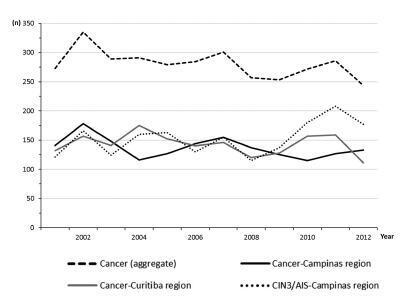-
Original Article06-01-2018
Cervical Cancer Registered in Two Developed Regions from Brazil: Upper Limit of Reachable Results from Opportunistic Screening
Revista Brasileira de Ginecologia e Obstetrícia. 2018;40(6):347-353
Abstract
Original ArticleCervical Cancer Registered in Two Developed Regions from Brazil: Upper Limit of Reachable Results from Opportunistic Screening
Revista Brasileira de Ginecologia e Obstetrícia. 2018;40(6):347-353
Views171Abstract
Objective
The aim of this study was to assess the time trends and pattern of cervical cancer diagnosed in the period from 2001 to 2012 by means of an opportunistic screening program from two developed regions in Brazil.
Methods
An observational study analyzing 3,364 cancer records (n = 1,646 from Campinas and n = 1,718 from Curitiba region) available in hospital-based cancer registries was done. An additional 1,836 records of CIN3/AIS from the region of Campinas was analyzed. The statistical analysis assessed the pooled data and the data by region considering the year of diagnosis, age-group, cancer stage, and histologic type. The Cochran-Armitage trend test was applied and p-values < 0.05 were considered significant.
Results
The total annual cervical cancer registered from2001 to 2012 showed a slight drop (273-244), with an age average of 49.5 y, 13 years over the average for CIN3/AIS (36.8 y). A total of 20.6% of the diagnoses (1.6% under 25 y) were done out of the official screening age-range. The biennial rate of diagnoses by age group for the region of Campinas showed an increase trend for the age groups under 25 y (p = 0.007) and 25 to 44 y (p = 0.003). Stage III was the most recorded for both regions, with an annual average of 43%, without any trend modification. There was an increasing trend for stage I diagnoses in the region of Campinas (p = 0.033). The proportion of glandular histologic types registered had an increased trend over time (p = 0.002), higher for the region of Campinas (21.1% versus 12.5% for the region of Curitiba).
Conclusion
The number, pattern and trends of cervical cancer cases registered had mild and slow modifications and reflect the limited effectivity of the opportunistic screening program, even in developed places.
Key-words Cervical cancerCervical intraepithelial neoplasiaEpidemiologypreventive medicinePublic healthSee more


